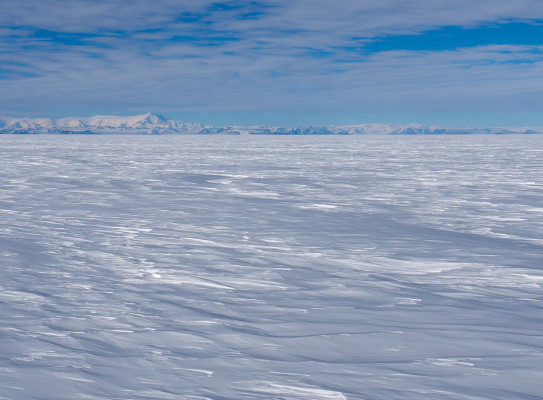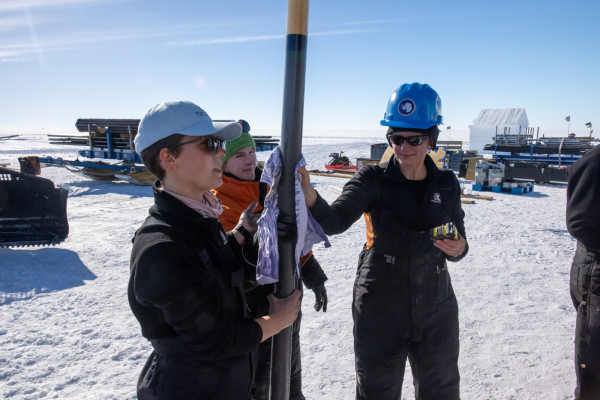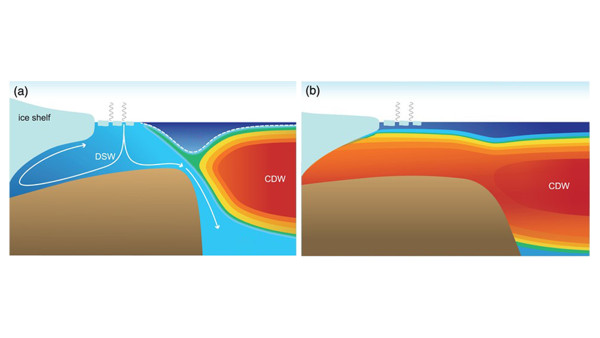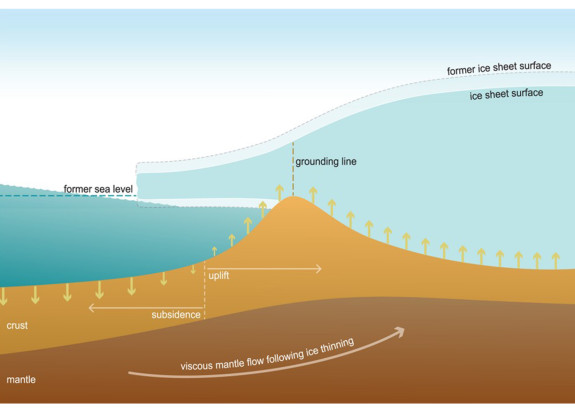It’s not too late to save the West Antarctic Ice Sheet, study shows

New research has found a ‘missing piece in the puzzle’ of West Antarctic Ice Sheet melt, revealing the collapse of the ice sheet in the Ross Sea region can be prevented – if we keep to a low-emissions pathway.
More than five metres of potential global sea-level rise is locked within the West Antarctic Ice Sheet, so understanding whether the regions of the ice sheet that appear ‘stable’ today might melt in the future is critical for forecasting how much and how fast our seas will rise around the world.
One such region that is currently stable is West Antarctica’s Siple Coast, where rivers of ice flow over the continent and drain into the Ross Sea. This ice flow is slowed down by the Ross Ice Shelf, a floating mass of ice nearly the size of Spain, which serves as a buttress to the ice sheet glaciers. Compared to other ice shelves in West Antarctica, the Ross Ice Shelf has very little melting at its base due to the very cold ocean waters that travel through the ocean gateway below.
But this region of the ice sheet has not always been stable. Radiocarbon dating of sediments from beneath the ice sheet show that it retreated (melted) by hundreds of kilometres around 7000 years ago, and then readvanced (grew) to its present position within the last 2000 years.

A new study from GNS Science Te Pū Ao, Te Herenga Waka—Victoria University of Wellington, and an international team including NASA’s Jet Propulsion Laboratory, used computer model simulations to explain this ice sheet retreat and advance. The simulations looked at how changes in the ocean and Earth’s crust influenced the ice sheet.
“When we project future ice sheet response, we have to grapple with many uncertainties about which processes drive ice sheet behaviour,"says the lead author, Dan Lowry, GNS Science ice sheet and climate modeller.

Our study sought to unravel what happened to the West Antarctic Ice Sheet in this region in the past, in order to better predict what will happen in the future.
Deep ocean mixing the primary driver of West Antarctic Ice Sheet behaviour
When surface ocean water freezes as sea ice, salt is released. This creates very dense cold salty water that can mix deep into the ocean, including into ocean cavities such as the space under the Ross Ice Shelf. This dense water acts as a barrier between warmer ocean water and the ice shelf, preventing melting. But Antarctic ice cores and geological records show that in the past, this ocean mixing was weaker, which means melting rates may have been higher.

As an ice sheet shrinks in size, the change in ice load causes the Earth’s crust to slowly lift up in response. The rate of this crustal uplift depends on the viscosity – or ‘stickiness’ – of the mantle, the layer of the Earth beneath the crust. Crustal uplift as the ice sheet retreated thousands of years ago may have re-grounded the floating ice, allowing the ice sheet to stabilise and then advance again.

By comparing geological records with the simulations of ice sheet flow under different scenarios of mantle ‘stickiness’ and rates of ocean mixing, the study found that the retreat and advance of the ice sheet was best explained by changes in the ocean temperature, but that the rate of crustal response also impacts how sensitive the ice sheet is to the ocean. The ice sheet, ocean and solid earth all interact and influence each other.
Mitigation still matters
Recent research that found that in another part of West Antarctica – the Amundsen Sea Embayment – the ocean cavities beneath the ice shelves are already warm, melting is underway, with further melting “unavoidable” even if emissions are mitigated globally.
However, Lowry says this new study shows that it is still possible to prevent the retreat of the West Antarctic Ice Sheet in the Siple Coast region.
Our modelling has helped us understand what caused changes in the past; we know that by mitigating greenhouse to meet the Paris Agreement target, it is possible to limit that ocean warming to levels that won’t cause collapse of the ice sheet. This region is vulnerable, but we’re not there yet.
Global climate models run under high-emissions scenarios show less sea ice formation and less deep ocean mixing. This could lead to the same cold-to-warm ocean switch and extensive ice sheet retreat observed thousands of years ago.
Lowry says that the modelling incorporated a wider range of processes than previous models, for example changes in sea level that occur near the ice sheet as it melts, due to the ice sheet’s gravitational pull.
“We went more complex, we’ve tested these hypotheses in a more robust way than has been ever done before. This is a topic that the scientific community has been trying to figure out for several years; obtaining these results is like finding that missing piece in the puzzle of what makes ice sheets tick.”
Photo: The vast Ross Ice Shelf, with the Trans Antarctic Mountains pictured behind. Credit: Hugh Chittock / Antarctica New Zealand
-
Sea-level rise and low-emissions scenarios
Approximately 680 million people around the world live in low-lying coastal regions, and are exposed to hazards and impacts due to sea-level rise.
‘Low-emissions scenarios’ that will limit ocean warming to levels that won’t cause the collapse of the ice sheet are SSP1-2.6 of the IPCC Shared Socio-economic Pathways (SSPs) that meet the Paris Agreement target to keep global warming to well below 2°C above pre-industrial temperatures. The SSPs are based on different socio-economic assumptions that drive future greenhouse gas emissions.
-
Crustal response
The rate of crustal response depends on the viscosity – or ‘stickiness’ – of the mantle. A stickier mantle leads to a slower response. As mantle viscosity varies across Antarctica, some parts of the ice sheet will be more sensitive to future warming based upon the rate of crustal response.
The Amundsen Sea Embayment has been found to have relatively fast crustal rebound that is projected to delay ice sheet retreat by decades. This study’s model predicts a slower crustal response on the Siple Coast if ice thinning and retreat are initiated, meaning if the cold-warm ocean switch occurs the rate of retreat could be more extreme in this area.
-
SWAIS2C - Sensitivity of the West Antarctic Ice Sheet to Two Degrees Celsius of Warming
With only a few decades of observations from satellite records available, geological records – data from sediments and ice cores – provide key information to test models and reduce uncertainty in future projections. The SWAIS 2C project, co-led by GNS Science, Te Herenga Waka – Victoria University of Wellington, and Antarctica New Zealand, aims to retrieve a sediment core from the Siple Coast that is expected to reach back hundreds of thousands of years, and potentially even millions of years. These records will provide further opportunity to test the models developed in this study.
-
Research and funding details
Ocean cavity regime shift reversed West Antarctic grounding line retreat in the late Holocene was published in the Nature Communications scientific journal. Dan Lowry (GNS Science) led an international team of authors from Victoria University of Wellington – Te Herenga Waka’s Antarctic Research Centre, Los Alamos National Laboratory, Jet Propulsion Laboratory – California Institute of Technology, and McGill University.
The research was supported by the Ministry of Business, Innovation and Employment (MBIE) through the Antarctic Science Platform and GNS Science Global Change through Time programme.